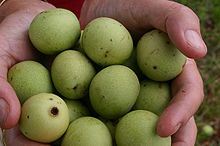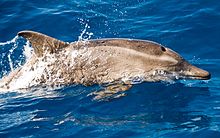
A drink or beverage is a liquid intended for human consumption. In addition to their basic function of satisfying thirst, drinks play important roles in human culture. Common types of drinks include plain drinking water, milk, juice, smoothies and soft drinks. Traditionally warm beverages include coffee, tea, and hot chocolate. Caffeinated drinks that contain the stimulant caffeine have a long history.

Alcohol intoxication, also known in overdose as alcohol poisoning, commonly described as drunkenness or inebriation, is the behavior and physical effects caused by a recent consumption of alcohol. In addition to the toxicity of ethanol, the main psychoactive component of alcoholic beverages, other physiological symptoms may arise from the activity of acetaldehyde, a metabolite of alcohol. These effects may not arise until hours after ingestion and may contribute to the condition colloquially known as a hangover.

Food is any substance consumed by an organism for nutritional support. Food is usually of plant, animal, or fungal origin and contains essential nutrients such as carbohydrates, fats, proteins, vitamins, or minerals. The substance is ingested by an organism and assimilated by the organism's cells to provide energy, maintain life, or stimulate growth. Different species of animals have different feeding behaviours that satisfy the needs of their metabolisms and have evolved to fill a specific ecological niche within specific geographical contexts.
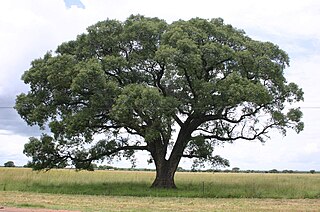
Sclerocarya birrea, commonly known as the marula, is a medium-sized deciduous fruit-bearing tree, indigenous to the miombo woodlands of Southern Africa, the Sudano-Sahelian range of West Africa, the savanna woodlands of East Africa and Madagascar.

Jacobus Johannes Uys, better known as Jamie Uys, was a South African film director, best known for directing the 1980 comedy film The Gods Must Be Crazy and its 1989 sequel The Gods Must Be Crazy II. Uys also directed the 1974 documentary film Animals Are Beautiful People.

Purposeful production of alcoholic drinks is common and often reflects cultural and religious peculiarities as much as geographical and sociological conditions.

Zoopharmacognosy is a behaviour in which non-human animals self-medicate by selecting and ingesting or topically applying plants, soils and insects with medicinal properties, to prevent or reduce the harmful effects of pathogens, toxins, and even other animals. The term derives from Greek roots zoo ("animal"), pharmacon, and gnosy ("knowing").
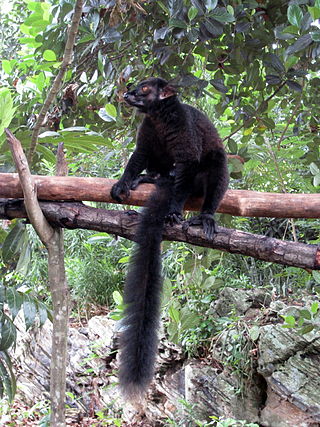
The black lemur is a species of lemur from the family Lemuridae. Like all lemurs, it is endemic to Madagascar. Originally, the species was thought to have two subspecies, Eulemur macaco macaco and Eulemur macaco flavifrons, both of which were elevated to species status by Mittermeier et al. in 2008 to Eulemur macaco and Eulemur flavifrons respectively. The most startling difference between the two species is the eye colour; Eulemur flavifrons, the blue-eyed black lemur, has blue eyes, while Eulemur macaco, the black lemur, has brown or orange eyes, and also has ear tufts.

Animals Are Beautiful People is a 1974 South African nature documentary written, produced, directed, filmed and edited by Jamie Uys, about the wildlife in Southern Africa, presented with comedic elements. It was filmed in the Namib Desert, the Kalahari Desert and at the Okavango River and Okavango Delta. It was the recipient of the 1974 Golden Globe Award for Best Documentary Film.
An alcohol enema, also known colloquially as butt-chugging or boofing, is the act of introducing alcohol into the rectum and colon via the anus, i.e., as an enema. This method of alcohol consumption can be dangerous and even deadly because it leads to faster intoxication than drinking since the alcohol is absorbed directly into the bloodstream and bypasses the body's ability to reject the toxin by vomiting.
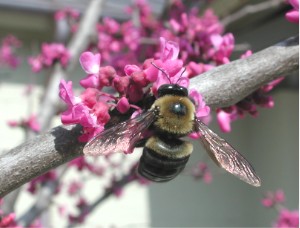
Bees can suffer serious effects from toxic chemicals in their environments. These include various synthetic chemicals, particularly insecticides, as well as a variety of naturally occurring chemicals from plants, such as ethanol resulting from the fermentation of organic materials. Bee intoxication can result from exposure to ethanol from fermented nectar, ripe fruits, and manmade and natural chemicals in the environment.

Alcoholic beverages appear in the Hebrew Bible, after Noah planted a vineyard and became inebriated. In the New Testament, Jesus miraculously made copious amounts of wine at the wedding at Cana. Wine is the most common alcoholic beverage mentioned in biblical literature, where it is a source of symbolism, and was an important part of daily life in biblical times. Additionally, the inhabitants of ancient Israel drank beer, and wines made from fruits other than grapes, and references to these appear in scripture. However, the alcoholic content of ancient alcoholic beverages were significantly lower than modern alcoholic beverages. The low alcoholic content was due to the limitations of fermentation and nonexistence of distillation methods in the ancient world. Rabbinic teachers wrote acceptance criteria on consumability of ancient alcoholic beverages after significant dilution with water, but prohibited undiluted wine.

An alcoholic beverage is a drink that contains ethanol, a type of alcohol that acts as a drug and is produced by fermentation of grains, fruits, or other sources of sugar. The consumption of alcoholic drinks, often referred to as "drinking", plays an important social role in many cultures. Most countries have laws regulating the production, sale, and consumption of alcoholic beverages, and the temperance movement advocates against the consumption of alcoholic beverages. Regulations may require the labeling of the percentage alcohol content and the use of a warning label. Some countries ban such activities entirely, but alcoholic drinks are legal in most parts of the world. The global alcoholic drink industry exceeded $1.5 trillion in 2017.

The cuisine of Rwanda is based on local staple foods produced by the traditional subsistence-level agriculture and has historically varied across different areas.
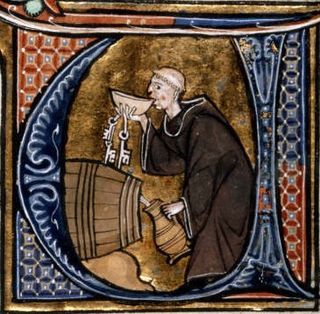
The world's religions have had differing relationships with alcohol. Many religions forbid alcoholic consumption or see it as sinful or negative. Others have allocated a specific place for it, such as in the Christian practice of using wine during the Eucharist rite.

A psychoactive drug, psychopharmaceutical, psychoactive agent, or psychotropic drug is a chemical substance that changes the function of the nervous system and results in alterations of perception, mood, cognition, and behavior. These substances may be used medically, recreationally, for spiritual reasons, or for research. Some categories of psychoactive drugs may be prescribed by physicians and other healthcare practitioners because of their therapeutic value.

Self-anointing in animals, sometimes called anointing or anting, is a behaviour whereby a non-human animal smears odoriferous substances over themselves. These substances are often the secretions, parts, or entire bodies of other animals or plants. The animal may chew these substances and then spread the resulting saliva mixture over their body, or they may apply the source of the odour directly with an appendage, tool or by rubbing their body on the source.

Alcohol, sometimes referred to by the chemical name ethanol, is a depressant drug that is the active ingredient in fermented drinks such as beer, wine, and distilled spirits. It is one of the oldest and most commonly consumed recreational drugs, causing the characteristic effects of alcohol intoxication ("drunkenness"). Among other effects, alcohol produces happiness and euphoria, decreased anxiety, increased sociability, sedation, impairment of cognitive, memory, motor, and sensory function, and generalized depression of central nervous system (CNS) function.

Khamr is an Arabic word for wine; intoxication; the plural form, Khumūr, is defined as alcoholic beverages, wine; liquor. In fiqh, it refers to certain forbidden substances, and its technical definition depends on the madhhab or legal school. Most jurists, including those from the Maliki, Shafiʽi, Hanbali, Ahl-i Hadith legal schools have traditionally viewed it as general term for any intoxicating beverage made from grapes, dates, and similar substances. Hanafi jurists restricted the term to a narrower range of beverages. Over time, some jurists classified other intoxicants, such as opium and khat, as khamr, based on a hadith stating, "The Holy Prophet said: 'every intoxicant is khamr, and every intoxicant is forbidden.'"
